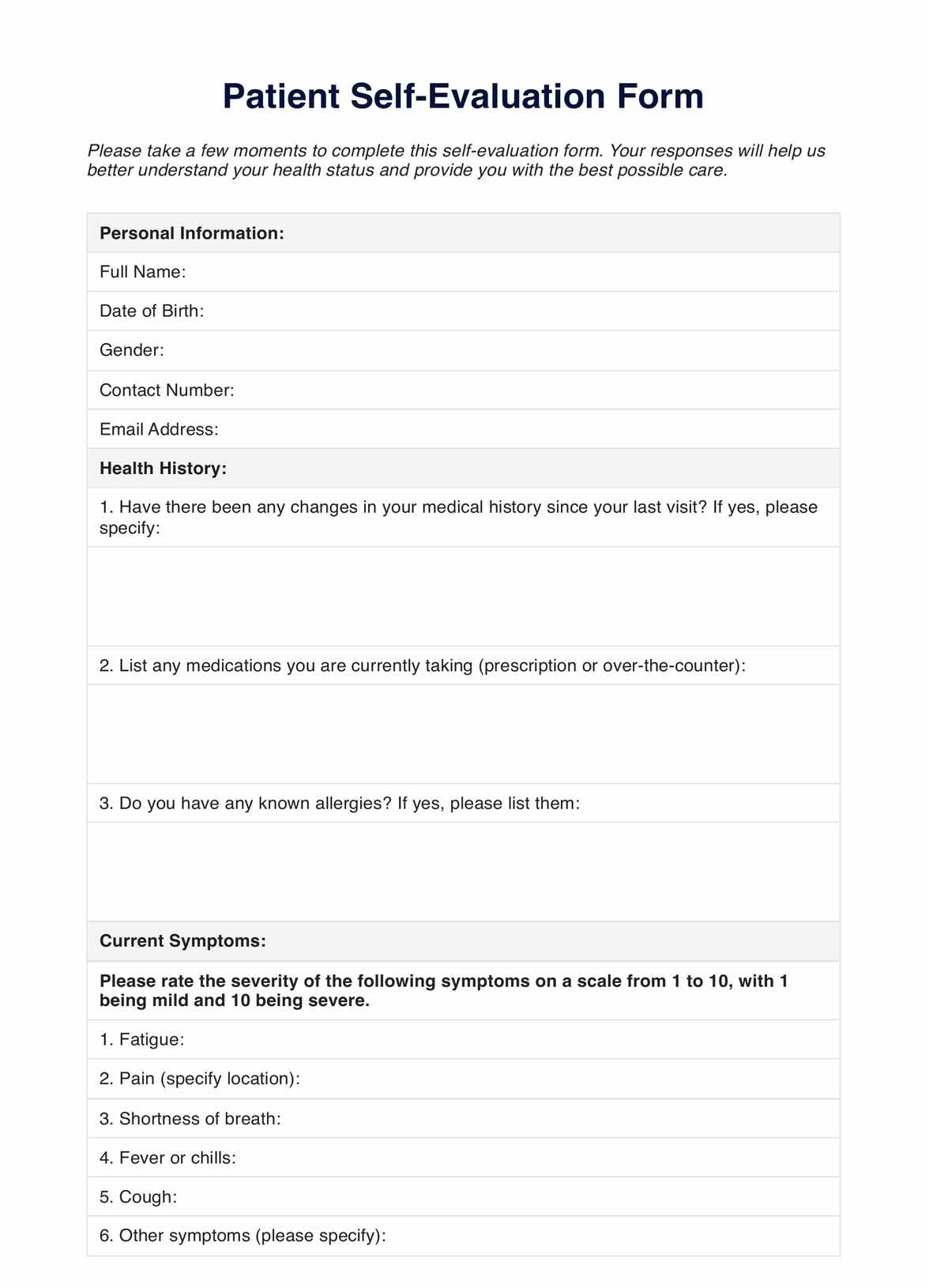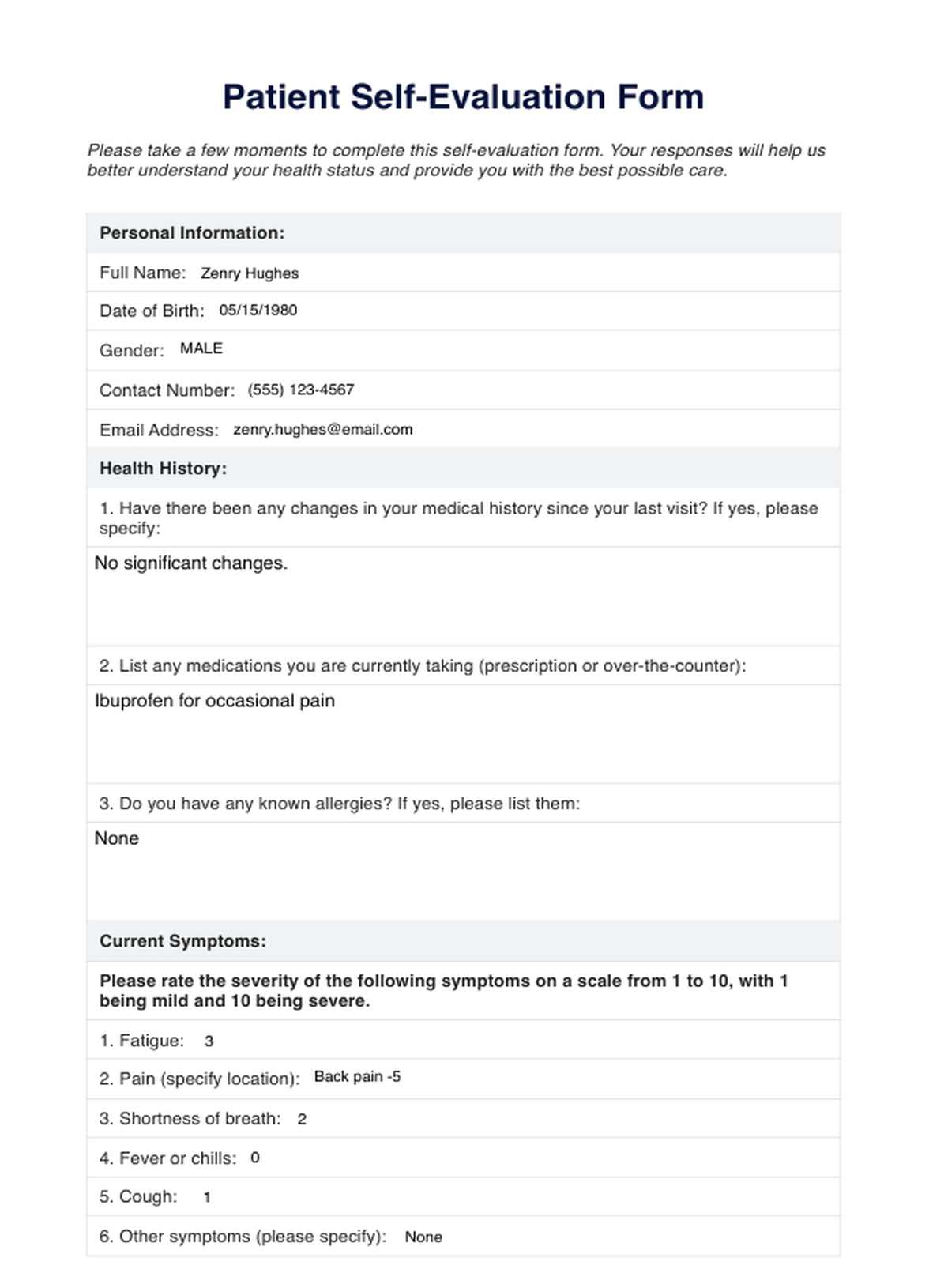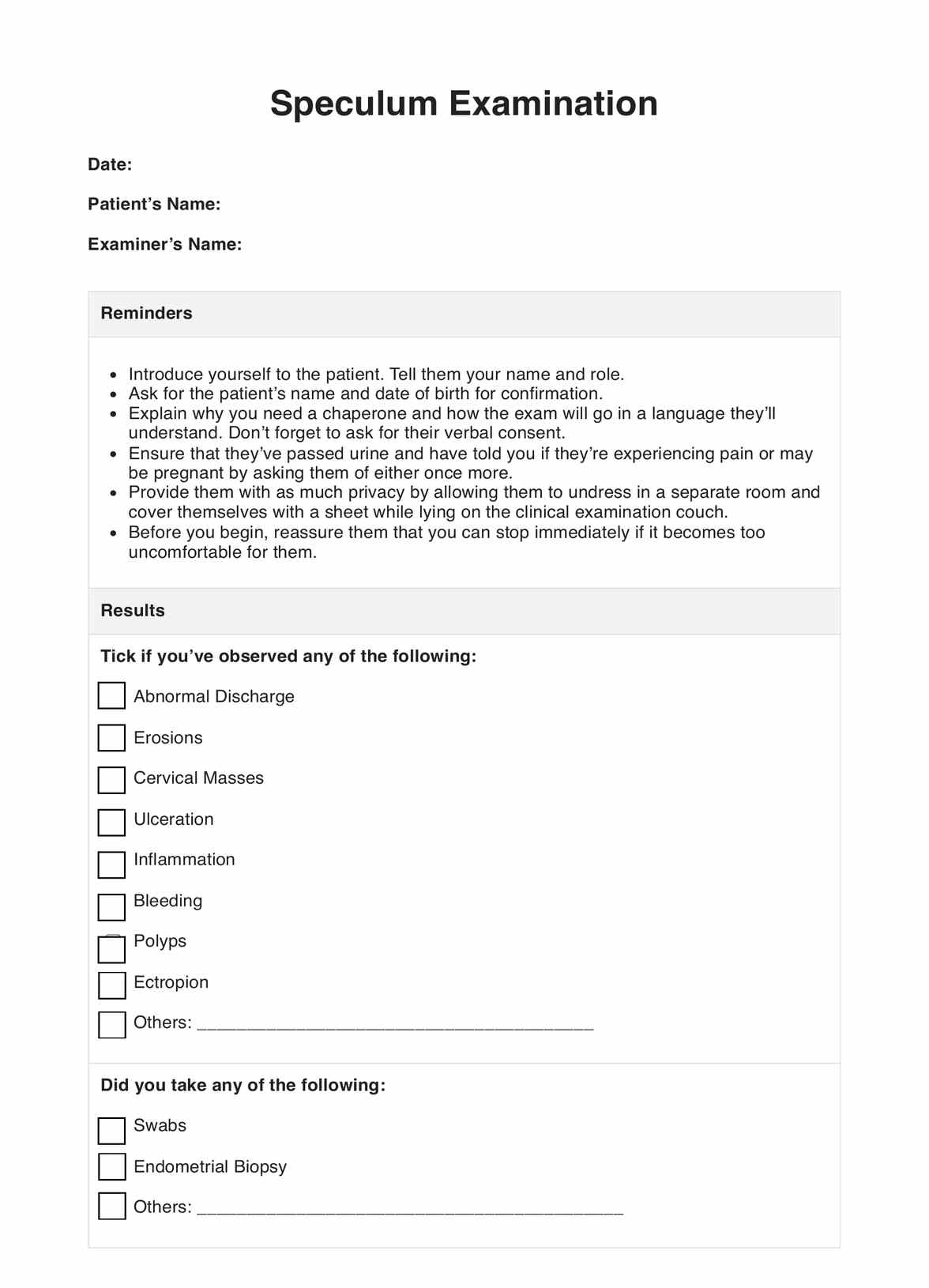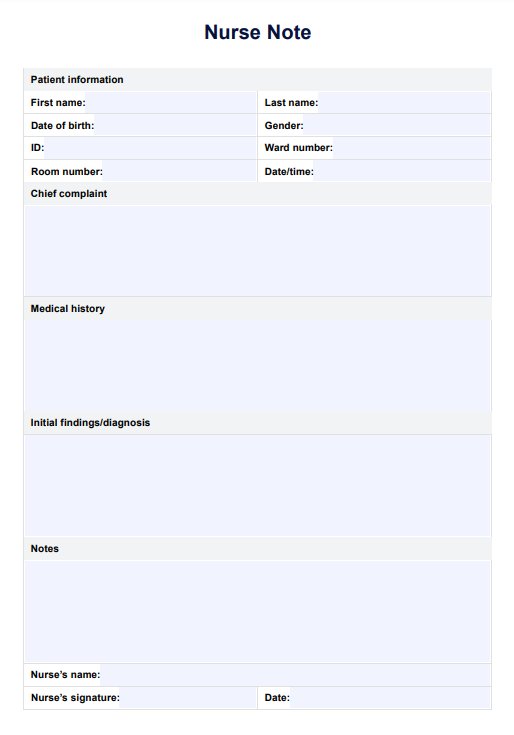Patient Self Evaluation
Download Carepatron's free PDF example of a patient self-evaluation form to help individuals assess their health status and communicate effectively with their healthcare providers.


What is a Patient Self-Evaluation?
Patient Self-Evaluation is a proactive approach that empowers individuals to actively participate in assessing their own health status, symptoms, and overall well-being. It involves a structured process where individuals systematically evaluate various aspects of their health, enabling them to gain insights into their conditions, track progress, and make informed decisions in collaboration with healthcare professionals.
This self-assessment typically includes an honest reflection on physical, emotional, and mental aspects. Patients assess factors such as pain levels, energy levels, emotional states, and the impact of their health on daily activities. Importantly, it goes beyond mere symptom tracking – patient self-evaluation encourages individuals to consider the broader context of their lives, considering lifestyle factors, stressors, and environmental influences.
The importance of Patient Self-Evaluation lies in fostering a proactive and engaged role in one's healthcare journey. By regularly assessing their health status, individuals can detect subtle changes, identify patterns, and communicate effectively with healthcare providers. This process enhances the accuracy of diagnoses, facilitates personalized treatment plans, and promotes a sense of autonomy in managing one's health.
Patient Self Evaluation Template
Patient Self Evaluation Example
How to do a self-evaluation
Engaging in a Patient Self-Evaluation is a constructive and accessible way to actively participate in your healthcare journey. Follow these clear steps to conduct a comprehensive self-care assessment, empowering you to take charge of your health.
1. Set the stage
Before initiating your self-evaluation, find a quiet and comfortable space to focus without distractions. Ensure you have ample time to complete the assessment thoroughly. This step is crucial for obtaining accurate insights into your well-being.
2. Gather relevant information
Start by collecting pertinent information such as your medical history, recent test results, and details about your current medications. Having this information at hand will enhance the accuracy of your self-assessment and aid in better communication with healthcare providers.
3. Physical assessment
Conduct a comprehensive physical assessment by paying attention to your body's signals. Evaluate factors like pain levels, energy levels, and any notable changes in your physical condition. Note any symptoms or discomfort you may be experiencing.
4. Emotional and mental well-being check
Assess your emotional and mental well-being by reflecting on your mood, stress levels, and overall mental state. Acknowledge any emotional challenges or stressors that may be impacting your health.
5. Assess daily activities
Evaluate how your health is influencing your daily activities. Assess any limitations or changes in your ability to perform routine tasks. This step provides valuable insights into the practical implications of your health in your daily life.
6. Account environmental factors
Consider external factors impacting your health, such as lifestyle choices, work environment, and stressors. Understanding these influences allows for a more comprehensive assessment and better-informed decision-making.
How to use this template?
This Patient Self-Evaluation template serves as a practical tool to streamline the self-assessment process, enabling patients to actively contribute to their healthcare journey. Understanding how to effectively utilize this resource ensures a seamless experience in gauging and monitoring your health.
The structured format ensures that important details are not overlooked, providing a holistic view of one's health status. Here are the steps to use the template:
1. Introduction and instructions
Begin by carefully reading the introduction and instructions provided in the template. Familiarize yourself with each section's purpose and the self-evaluation's overall goal.
2. Personal information
Enter your personal details accurately, including your name, date of birth, and any relevant identification numbers. Providing correct information is crucial for maintaining the integrity of your health records.
3. Medical history
Complete the section dedicated to your medical history. Include details about existing conditions, past surgeries, and any chronic illnesses. This information provides essential context for understanding your overall health profile.
4. Symptom assessment
Use the designated spaces to document any symptoms you may be experiencing. Include details such as symptoms' nature, frequency, and any factors that exacerbate or alleviate them. This section aids in pinpointing potential health issues.
5. Daily activities and impact on routine
Reflect on how your health is influencing your daily activities. Provide insights into any limitations or changes in your ability to perform routine tasks. Understanding the practical implications of your health is crucial for tailored healthcare solutions.
6. Emotional and mental well-being
Evaluate your emotional and mental state using the provided prompts. This section allows you to articulate any stressors or challenges that may be affecting your overall well-being.
7. Conclusion and next steps
Summarize your findings and outline any immediate concerns or questions you may have. This conclusion is useful when discussing your self-evaluation with healthcare professionals.
When to do a Patient Self Evaluation
Patient Self-Evaluation is a valuable practice that becomes particularly essential in various scenarios, helping individuals proactively manage their health and communicate effectively with healthcare providers. Understanding when to conduct a self-evaluation ensures timely and relevant insights into one's well-being.
1. Regular health check-ups
Performing a self-evaluation regularly, even in the absence of apparent symptoms, contributes to preventive healthcare. Regular check-ups enable individuals to monitor subtle changes, identify potential risk factors, and address health concerns proactively.
2. Experiencing new or persistent symptoms
Initiate a self-evaluation when experiencing new or persistent symptoms. Documenting details about symptoms' nature, intensity, and duration provides valuable information for healthcare professionals to make accurate diagnoses and recommend appropriate interventions.
3. Before medical appointments
Conduct a self-assessment before scheduled medical appointments. This ensures that patients are well-prepared to discuss their health status with healthcare providers, facilitating more efficient and focused consultations.
4. Changes in medication or treatment plans
When there are changes in medication, treatment plans, or lifestyle, performing a self-evaluation helps individuals track the impact of these adjustments on their health. This information aids healthcare providers in making informed decisions about ongoing care.
5. Post-hospitalization or surgery
After hospitalization or surgery, patients can use a self-evaluation to monitor their recovery progress. Tracking changes in symptoms, energy levels, and overall well-being assists both patients and healthcare providers ensure a smooth recovery process.
6. Stressful life events
During periods of heightened stress or major life events, self-evaluation is beneficial. Emotional and mental well-being can significantly impact physical health, and addressing these aspects through self-assessment fosters a holistic approach to healthcare.
Commonly asked questions
Completing a self-evaluation questionnaire empowers patients by providing a structured approach to articulate their health concerns, aiding healthcare providers in comprehensive assessments and personalized care planning.
Self-evaluation in healthcare is crucial as it promotes early detection of symptoms, enhances patient-provider communication, and fosters a proactive approach to well-being, ultimately contributing to improved health outcomes.
Creating a Patient Self-Evaluation document on Carepatron is straightforward. Utilize the platform's intuitive interface to design a customized form, incorporating relevant sections for medical history, symptoms, and daily activities, ensuring a comprehensive and user-friendly self-assessment tool.
















































































































